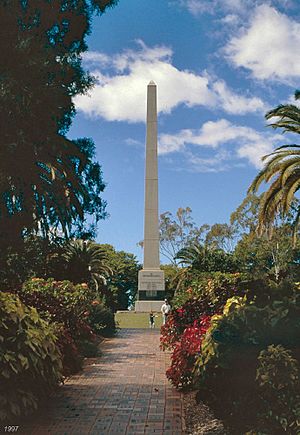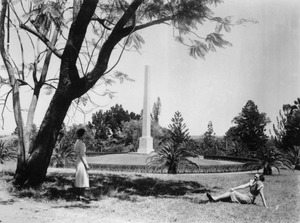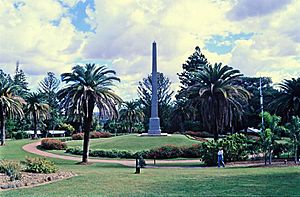Rockhampton War Memorial facts for kids
Quick facts for kids Rockhampton War Memorial |
|
|---|---|

Rockhampton War Memorial, 1997
|
|
| Location | Penlington Street, The Range, Rockhampton, Rockhampton Region, Queensland, Australia |
| Design period | 1919 - 1930s (interwar period) |
| Built | 1924 |
| Official name: Rockhampton War Memorial | |
| Type | state heritage (built) |
| Designated | 21 October 1992 |
| Reference no. | 600818 |
| Significant period | 1924- (social) 1924 (historical, fabric) |
| Significant components | war trophy/ies, memorial - obelisk, garden - bed/s, trees/plantings, mound/s, pathway/walkway |
| Lua error in Module:Location_map at line 420: attempt to index field 'wikibase' (a nil value). | |
The Rockhampton War Memorial is a special monument located in the Rockhampton Botanic Gardens in Rockhampton, Queensland, Australia. It was built in 1924 to remember those who served in the First World War. This memorial is so important that it was added to the Queensland Heritage Register on October 21, 1992.
Building the Memorial
The Rockhampton War Memorial was officially opened on October 16, 1924. The Governor of Queensland, Sir Matthew Nathan, was there for the ceremony. The memorial was designed by architects Hockings and Palmer and built by a company called F M Allen. It is made of granite and honors everyone who served in the First World War.
Why a Memorial?
After the First World War ended in 1918, people in Rockhampton wanted to build something to remember the soldiers. In February 1919, a public meeting was held. They decided to build a memorial for the whole region, not just Rockhampton.
At first, they wanted to put it by the river. They even held a competition for the best design. But most of the designs were too expensive.
Choosing the Design
In 1922, the committee asked local architects Hockings and Palmer to design a memorial. They decided to place it in the Rockhampton Botanic Gardens. Hockings and Palmer's design cost £2,654, which was a lot of money back then. Rockhampton builders, F M Allen, were hired to build it.
The Architects
The firm Hockings and Palmer was a team of two architects: Edwin Morton Hockings and Leslie Tarween Palmer.
Edwin Hockings was the son of Albert John Hockings, who was the mayor of Brisbane twice. Edwin trained as an architect and moved to Rockhampton in 1895. He even served in the Second Boer War and the First World War.
Less is known about Leslie Palmer. He studied in Melbourne and worked in Sydney before coming to Rockhampton. He joined Edwin Hockings in 1916, and they worked together until 1938.
Rockhampton's Early Days
The area around Rockhampton was first explored by Ludwig Leichhardt and Thomas Mitchell in the 1840s. Later, the Archer brothers found the Fitzroy River in 1853. This led to the area becoming important for farming. The city of Rockhampton grew quickly after gold was found nearby in Canoona in 1858.
The Botanic Gardens
The Rockhampton Botanic Gardens were started in 1869. The mayor asked the government to turn a piece of land into gardens, and they agreed. A gardener was hired in 1873. A French man named Monsieur Anthelme Thozet helped a lot by planting trees from his own nursery. The first gardener, J S Edgar, learned from Thozet. Later, R Simmons became the curator, or manager, of the gardens. He was a naturalist and designed the area where the memorial now stands.
Why War Memorials are Important
Before the First World War, Australia didn't have many public monuments. The memorials built after this war were some of our first national monuments. They show how much the war affected Australia. About 60,000 Australians died, which was a huge number for a country of only 4 million people.
Even before the war ended, people started building memorials. They were like sacred graves for soldiers whose bodies were buried overseas. The word "cenotaph" means "empty tomb."
Australian war memorials are special because they honor everyone who served, not just those who died. Australians were proud that their army was made up of volunteers. Many memorials show how much the local community was involved in the war.
These memorials also show the skills of local stonemasons, metalworkers, and architects. In Queensland, statues of soldiers were popular. But in southern states, tall, pointed monuments called obelisks were more common.
Many First World War memorials have been updated to include later conflicts. The Rockhampton War Memorial is one of the biggest and most expensive war memorials in Queensland. However, it doesn't have a list of soldiers' names on it. It was planned that a list would be kept at the Rockhampton Town Hall.
What the Memorial Looks Like
The First World War Memorial is in the middle of the Rockhampton Botanic Gardens.
It stands on a neat grass mound. A paved path leads up to it from the south. This path goes around the grass mound in a circle. There are garden beds and Canary Island Date Palms around the path. These palms are a symbol of victory. In the grass, there's a flower bed that spells out the word ANZAC. A old gun or war trophy is placed on the path leading to the memorial.
The memorial is about 64 feet (19.5 meters) tall. It is made of Grey granite from Gracemere. It has a base, then a large block called a plinth, and then a tall, pointed pillar called an obelisk.
The base has two steps with rough stone sides and smooth tops. The plinth is square. On the front of the main block, it says "IN REMEMBRANCE TO THOSE WHO FELL" and lists the dates of the First World War and later wars. A shiny granite plate has been added below with more dates. On the north side, the word "SACRIFICE" is carved.
The tall obelisk sits on top of the main block. It gets narrower as it goes up and ends in a pointed top.
Why it's a Heritage Site
The Rockhampton War Memorial was added to the Queensland Heritage Register on October 21, 1992. This means it's a very important historical place.
Showing Queensland's History
War memorials like this one show how Queensland's history has changed. They remind us of a time when people felt very proud of their country, especially during and after the First World War.
A Unique Memorial
This memorial is unusually large. It stands out in its surroundings and is the biggest and most expensive war memorial in Queensland. It's also special because it's still in its original setting, which is rare.
A Great Example
The monument is a unique historical record. It shows what people liked in terms of design between the two World Wars.
Built in 1924, the Rockhampton memorial is a great example of a monument built to remember a major historical event. It uses symbols like the obelisk to help us remember.
Beautiful Design
The memorial is also important because it is very well made and designed. It looks beautiful.
Important to the Community
This memorial has a strong and lasting connection with the community. It reminds people of the big impact of the war. It is also a central place for remembering those who served. It also has special links to the people who designed and built it, like architects Hockings and Palmer, the builders F M Allan, and the Botanic Gardens curator R Simmons.



